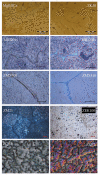Magnesium-Based Alloys Used in Orthopedic Surgery
- PMID: 35161092
- PMCID: PMC8840615
- DOI: 10.3390/ma15031148
Magnesium-Based Alloys Used in Orthopedic Surgery
Abstract
Magnesium (Mg)-based alloys have become an important category of materials that is attracting more and more attention due to their high potential use as orthopedic temporary implants. These alloys are a viable alternative to nondegradable metals implants in orthopedics. In this paper, a detailed overview covering alloy development and manufacturing techniques is described. Further, important attributes for Mg-based alloys involved in orthopedic implants fabrication, physiological and toxicological effects of each alloying element, mechanical properties, osteogenesis, and angiogenesis of Mg are presented. A section detailing the main biocompatible Mg-based alloys, with examples of mechanical properties, degradation behavior, and cytotoxicity tests related to in vitro experiments, is also provided. Special attention is given to animal testing, and the clinical translation is also reviewed, focusing on the main clinical cases that were conducted under human use approval.
Keywords: Mg-based alloys; biocompatibility; biomaterials; clinical translation; mechanical properties; orthopedy.
Conflict of interest statement
The authors declare no conflict of interest.
Figures














Similar articles
-
Biodegradable magnesium alloys as temporary orthopaedic implants: a review.Biometals. 2019 Apr;32(2):185-193. doi: 10.1007/s10534-019-00170-y. Epub 2019 Jan 18. Biometals. 2019. PMID: 30659451 Review.
-
[RESEARCH PROGRESS OF MAGNESIUM AND MAGNESIUM ALLOYS IMPLANTS IN ORTHOPEDICS].Zhongguo Xiu Fu Chong Jian Wai Ke Za Zhi. 2016 Dec 8;30(12):1562-1566. doi: 10.7507/1002-1892.20160321. Zhongguo Xiu Fu Chong Jian Wai Ke Za Zhi. 2016. PMID: 29786352 Review. Chinese.
-
Development of magnesium-based biodegradable metals with dietary trace element germanium as orthopaedic implant applications.Acta Biomater. 2017 Dec;64:421-436. doi: 10.1016/j.actbio.2017.10.004. Epub 2017 Oct 4. Acta Biomater. 2017. PMID: 28987782
-
The role of rare earth elements in biodegradable metals: A review.Acta Biomater. 2021 Jul 15;129:33-42. doi: 10.1016/j.actbio.2021.05.014. Epub 2021 May 19. Acta Biomater. 2021. PMID: 34022465 Review.
-
Current status and perspectives of zinc-based absorbable alloys for biomedical applications.Acta Biomater. 2019 Oct 1;97:1-22. doi: 10.1016/j.actbio.2019.07.034. Epub 2019 Jul 24. Acta Biomater. 2019. PMID: 31351253 Review.
Cited by
-
Research Progress of Titanium-Based Alloys for Medical Devices.Biomedicines. 2023 Nov 8;11(11):2997. doi: 10.3390/biomedicines11112997. Biomedicines. 2023. PMID: 38001997 Free PMC article.
-
Current developments and future perspectives of nanotechnology in orthopedic implants: an updated review.Front Bioeng Biotechnol. 2024 Mar 18;12:1342340. doi: 10.3389/fbioe.2024.1342340. eCollection 2024. Front Bioeng Biotechnol. 2024. PMID: 38567086 Free PMC article. Review.
-
Neodymium-modified Mg-Zn-Zr magnesium alloy as a biodegradable osteogenic implant.iScience. 2025 May 15;28(6):112677. doi: 10.1016/j.isci.2025.112677. eCollection 2025 Jun 20. iScience. 2025. PMID: 40530420 Free PMC article.
-
Advancements in biomaterials and bioactive solutions for lumbar spine fusion cages: Current trends and future perspectives.Bioact Mater. 2025 Jul 31;53:656-703. doi: 10.1016/j.bioactmat.2025.07.035. eCollection 2025 Nov. Bioact Mater. 2025. PMID: 40792114 Free PMC article. Review.
-
Mechanical and Computational Fluid Dynamic Models for Magnesium-Based Implants.Materials (Basel). 2024 Feb 8;17(4):830. doi: 10.3390/ma17040830. Materials (Basel). 2024. PMID: 38399081 Free PMC article.
References
-
- Kulinets I. Regulatory Affairs for Biomaterials and Medical Devices. Woodhead Publishing; Sawston, UK: 2014. Biomaterials and Their Applications in Medicine; pp. 1–10.
-
- Williams D. The Williams Dictionary of Biomaterials. Liverpool University Press; Liverpool, UK: 1999.
-
- Antoniac I.V., Albu M.G., Antoniac A., Rusu L.C., Ghica M.V. Collagen–Bioceramic Smart Composites. In: Antoniac I.V., editor. Handbook of Bioceramics and Biocomposites. Springer International Publishing; Cham, Switzerland: 2016. pp. 301–324.
-
- Laurencin C.T., Badon M.A. Biologics in Orthopaedic Surgery. Elsevier; St. Louis, MO, USA: 2019. Regenerative Engineering in the Field of Orthopedic Surgery; pp. 201–213.
-
- Vespa J., Medina L., Armstrong D.M. Demographic Turning Points for the United States: Population Projections for 2020 to 2060. U.S. Census Bureau; Suitland, MD, USA: 2020. p. 15.
Publication types
LinkOut - more resources
Full Text Sources

